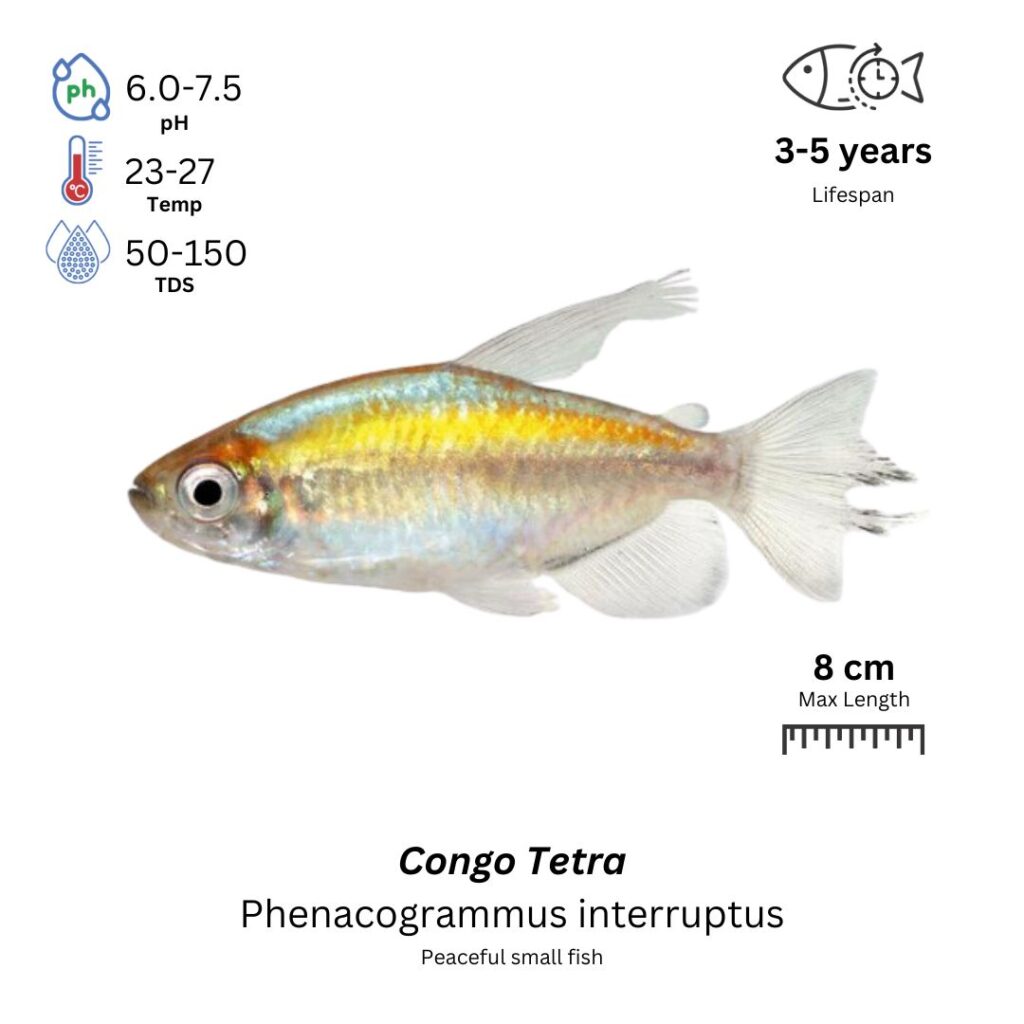Congo Tetra
Phenacogrammus interruptus

Description
The Congo Tetra is a vibrant, peaceful fish known for its striking coloration and shimmering body. They have elongated, semi-transparent bodies that display a mix of colors ranging from silver and gold to hints of blue and green, especially when caught in the light. Males are typically more colorful and display a more iridescent shine compared to females. The Congo Tetra’s fins also feature a beautiful red or orange hue, making them an eye-catching addition to any aquarium. These fish have a streamlined, elongated body, with a tall dorsal fin and long anal fins. Congo Tetras are peaceful, schooling fish that thrive in groups and enjoy swimming in the middle to upper areas of the tank. They are known for their social and calm nature, making them a great choice for community tanks.
Habitat Origin
Native to the Congo River Basin in Central Africa, where they inhabit slow-moving streams and rivers with dense vegetation. They are found in both clear and slightly turbid waters with moderate water flow.
Aquarium
Ideal Number in Aquarium: At least 6 individuals, as they are schooling fish and feel more secure in groups.
Favorite Food

Congo Tetras are omnivores and will accept a variety of foods, including high-quality flake food, micro pellets, and live or frozen foods like brine shrimp, bloodworms, and daphnia. They also enjoy plant matter, such as algae and biofilm, and will nibble on soft plant matter if it’s available in the tank.
Behavior:
Congo Tetras are peaceful, active, and social fish that do well in schools. They are non-aggressive and typically interact well with other small, peaceful species. These fish are often found swimming in the middle to upper regions of the tank, where they display their shimmering colors. They thrive when kept in groups, as their natural schooling behavior brings out their vibrant colors. While they are peaceful, Congo Tetras can be intimidated by large or aggressive tankmates, so they should be housed with similar-sized, non-aggressive species.
Special Care:
Congo Tetras do best in well-planted aquariums with plenty of hiding spots, such as plants, driftwood, and rocks. A tank with a moderate water flow and good filtration is ideal, as these fish come from slightly moving waters in their native habitat. Congo Tetras prefer stable water parameters, including a clean tank and regular water changes to maintain optimal health. While they are relatively hardy, it’s important to ensure stable water conditions to avoid stress.
Compatibility with Other Fish:
Yes, Congo Tetras are excellent tankmates for other small, peaceful species such as tetras, rasboras, and corydoras catfish. They are best kept in a community tank with non-aggressive fish that won’t stress them out. Their gentle nature makes them ideal for peaceful aquariums, but they should not be kept with larger or aggressive species that may harass or eat them.
Breeding Tank Setup
A separate breeding tank is strongly recommended for Congo Tetras to protect the eggs and provide a controlled environment. A 10-gallon (38 liters) tank is sufficient for a small group, while a 20-gallon (75 liters) setup is ideal for multiple pairs. Maintain a pH of 6.0–7.5, temperature between 24–28°C (75–82°F), and hardness of 4–12 dGH. Use fine gravel or sand as substrate, and include live plants like Java moss, Hornwort, or Anubias for egg attachment. Floating plants like Duckweed help provide shade and additional cover. Install a gentle sponge filter to maintain water clarity without producing strong currents. Use moderate lighting on a 12-hour cycle.
Conditioning for Breeding
To prepare Congo Tetras for spawning, feed them a nutritious and varied diet, including high-quality flake or micro pellets, live or frozen foods like brine shrimp, daphnia, and bloodworms, and occasional vegetable-based foods such as chopped spinach or peas. A protein-rich diet helps females develop eggs and enhances male coloration. Perform weekly water changes (20–30%) to maintain optimal conditions. A larger water change (~50%) and a small temperature increase to 28°C (82°F) can mimic rainy-season conditions that often trigger spawning.
Spawning Behavior
Spawning usually takes place in the early morning after optimal water changes. Males display vibrant colors to attract females, who then scatter their eggs among plants and substrate. The male fertilizes the eggs immediately, and a female can lay 100–300 small, sticky eggs in one session. Congo Tetras are known to consume their own eggs, so it’s essential to remove the parents immediately after spawning to protect the fertilized eggs.
Fry Development & Care
Congo Tetra eggs hatch within 2–3 days, depending on temperature. Newly hatched fry feed on their yolk sacs for the first few days. Once free-swimming, introduce infusoria or liquid fry food, followed by baby brine shrimp, microworms, or crushed flakes as they grow. Perform daily or alternate-day water changes (10–20%) to maintain water quality. Avoid overfeeding, as uneaten food can degrade water quality and harm the sensitive fry. Keep temperature stable at 24–28°C to support consistent development.
Maturity, Sexing & Stress Prevention
Congo Tetras reach sexual maturity at about 1 year of age. Males are typically more colorful, slimmer, and slightly smaller, while females appear fuller-bodied when gravid. During breeding, males may show brilliant red, yellow, and blue hues. Avoid stressing the fish with sudden changes in water parameters or aggressive tank mates. Clean water, stable conditions, and a calm tank environment are crucial for successful breeding and fry survival.
